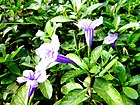Note: This is a project under development. The articles on this wiki are just being initiated and broadly incomplete. You can Help creating new pages.
Ruellia tuberosa - Minnieroot
Minnieroot is a species of flowering plant in the Acanthaceae family. Its native range is in Central America but presently it has become naturalized in many countries of tropical South and Southeast Asia.
Contents
- 1 Uses
- 2 Parts Used
- 3 Chemical Composition
- 4 Common names
- 5 Properties
- 6 Habit
- 7 Identification
- 8 List of Ayurvedic medicine in which the herb is used
- 9 Where to get the saplings
- 10 Mode of Propagation
- 11 How to plant/cultivate
- 12 Commonly seen growing in areas
- 13 Photo Gallery
- 14 References
- 15 External Links
Uses
high cholesterol, kidney diseases, joint pains, whooping cough, gonorrhea, syphilis, bladder stones, bronchitis, cancer
Parts Used
Chemical Composition
Leaves contain apigenin and luteolin, The seed oil yields myristic, capril and lauric acids, Study yielded flavonoids, glycosides, phenols, saponins and essential minerals with good nutritive value and secondary metabolites. [1]
Common names
| Language | Common name |
|---|---|
| Kannada | |
| Hindi | |
| Malayalam | |
| Tamil | |
| Telugu | |
| Marathi | NA |
| Gujarathi | NA |
| Punjabi | NA |
| Kashmiri | NA |
| Sanskrit | |
| English | Waterkanon, Watrakanu |
Properties
Reference: Dravya - Substance, Rasa - Taste, Guna - Qualities, Veerya - Potency, Vipaka - Post-digesion effect, Karma - Pharmacological activity, Prabhava - Therepeutics.
Dravya
Rasa
Tikta (Bitter), Kashaya (Astringent)
Guna
Laghu (Light), Ruksha (Dry), Tikshna (Sharp)
Veerya
Ushna (Hot)
Vipaka
Katu (Pungent)
Karma
Kapha, Vata
Prabhava
Habit
Identification
Leaf
| Kind | Shape | Feature |
|---|---|---|
| Simple | The leaves are divided into 3-6 toothed leaflets, with smaller leaflets in between |
Flower
| Type | Size | Color and composition | Stamen | More information |
|---|---|---|---|---|
| Unisexual | 5-5.5 cm long | blue-violet | 5-20 | Flowers shortly Pedicellate, Blue-violet, Showy. |
Fruit
| Type | Size | Mass | Appearance | Seeds | More information |
|---|---|---|---|---|---|
| scabrescent | 2.3-2.5 cm | clearly grooved lengthwise, Lowest hooked hairs aligned towards crown | With hooked hairs | 24-28 | {{{6}}} |
Other features
List of Ayurvedic medicine in which the herb is used
- Vishatinduka Taila as root juice extract
Where to get the saplings
Mode of Propagation
How to plant/cultivate
An ideal location for growing ruellia is a site with full sun exposure. Although ruellia flowers are highly adaptable and may do well in shade, expect fewer blooms due to the lack of sunlight.[3]
Commonly seen growing in areas
Open waste places, meadows, Borders of forests and fields.
Photo Gallery
References
External Links
- Ayurvedic Herbs known to be helpful to treat high cholesterol
- Ayurvedic Herbs known to be helpful to treat kidney diseases
- Ayurvedic Herbs known to be helpful to treat joint pains
- Ayurvedic Herbs known to be helpful to treat whooping cough
- Ayurvedic Herbs known to be helpful to treat gonorrhea
- Ayurvedic Herbs known to be helpful to treat syphilis
- Ayurvedic Herbs known to be helpful to treat bladder stones
- Ayurvedic Herbs known to be helpful to treat bronchitis
- Ayurvedic Herbs known to be helpful to treat cancer
- Herbs with Roots used in medicine
- Herbs with Leaves used in medicine
- Herbs with common name in English
- Habit - Small herb
- Index of Plants which can be propagated by Seeds
- Index of Plants which can be propagated by Cuttings
- Herbs that are commonly seen in the region of Open waste places
- Herbs that are commonly seen in the region of meadows
- Herbs that are commonly seen in the region of Borders of forests and fields
- Herbs




